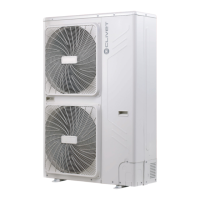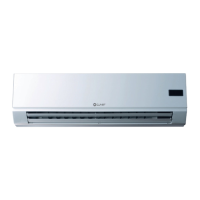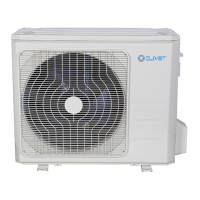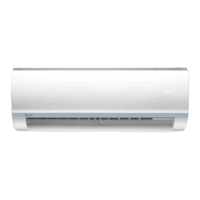43
Starting up the system
In case the refrigerant tank is insucient for a complete
charge, close the three valves on the pressure gauge, start
the outdoor unit in cooling mode, then open (C) and (B).
Connect the yellow pipe to a new tank and resume
charging until the desired charge is complete. Close the
valve (C) and (B).
a
CAUTION
Before starting the system, make sure to
complete all the checks/controls required
before initial start-up (see paragraph “8.1 Start-
up preparations” page 50) and make sure to
open all the stop valves. Starting the system
with the stop valves closed can cause damage
to the compressor.
FULL REFRIGERANT CHARGE
If a full charge of refrigerant is required (e.g. after moving/
replacing the unit or after a leak), the total refrigerant
charge will be the sum of the factory refrigerant pre-charge
+ the additional charge.
d
IT IS PROHIBITED TO
mix dierent types of refrigerant
R410A refrigerant is chemically stable, of low toxicity and
non-flammable, and belongs to the family of HFCs. R410A
is a mixture of R32 refrigerant (50%) and R125 (50%), with
properties very close to that of an azeotropic mixture (it
behaves almost as a pure gas) with a negligible glide
temperature (about 0.2 Celsius degrees with the split
system under normal operating conditions). It is also neither
explosive nor inflammable, it has low toxicity (safety lass A1,
like R22) and it is not corrosive under normal conditions.
The permitted limit of exposure is the same as that of
R407C and R22.
R410A is a “nearly azeotropic” mixture of two refrigerant
gases (R32 and R125). The “nearly azeotropic” condition
refers to a state in which the dew point curve and the boiling
point curve (gas/liquid equilibrium curves at constant
pressure) almost overlap. With this chemical characteristic,
the refrigerant mixture undergoes negligible changes in
composition when a change of state occurs (evaporation
or condensation). Consequently, even when a loss of
refrigerant in the gas phase occurs, the composition of the
refrigerant undergoes a negligible change.
Therefore, in the event of small leaks of refrigerant, R410A
can be treated in the same way as pure refrigerant R22, and
can be topped up in small quantities. On the other hand,
in case of replacement of a component of the refrigeration
circuit, or a more serious leak, the normal procedures
must be observed, recovering all the refrigerant fluid. After
eliminating the leak or carrying out the repair, the system
must be completely evacuated to eliminate the air and
then recharged with virgin gas. The recovered gas cannot
be reused.
MAXIMUM LEVEL OF CONCENTRATION
The calculation of the maximum concentration of refrigerant
is directly related to the space in which the refrigerant can
leak, and to the quantity of refrigerant charge.
The unit of measurement of concentration is kg/m
3
(weight
of the gaseous refrigerant that has a volume of 1 m
3
in the
space).
The maximum permitted level of concentration must
comply with the applicable regulations and local standards.
In accordance with the European standards that apply, the
maximum permitted concentration of R410 in the space
occupied by human beings is limited to 0.44 kg/m
3
.
PRECAUTIONS FOR REFRIGERANT LEAKS
This air conditioner uses a harmless and non-flammable
refrigerant. The room in which the appliance is installed
must be large enough to prevent a refrigerant leak from
reaching a critical concentration. It is therefore important
to take some essential precautions.
Critical concentration: maximum concentration at which
freon is harmless to humans.
Critical concentration of refrigerant: 0.44[kg/m3] for R410A.
Check the critical concentration with the procedure below
and take the necessary measures.
– Calculate the sum of the charge volumes (A[kg])
Total refrigerant volume of 10HP=refrigerant volume
pre-charged in the factory + subsequent additions.
– Calculate the room cubage (B[m
3
]) (minimum
cubage).
– Calculate the refrigerant concentration (A/B)≤
Critical concentration.
Countermeasure in case of excessive concentration:
– Install a mechanical fan to lower the refrigerant
concentration below the critical value (ventilate
regularly).
– If the room cannot be ventilated regularly,
install a leak detection device connected to the
mechanical fan.

